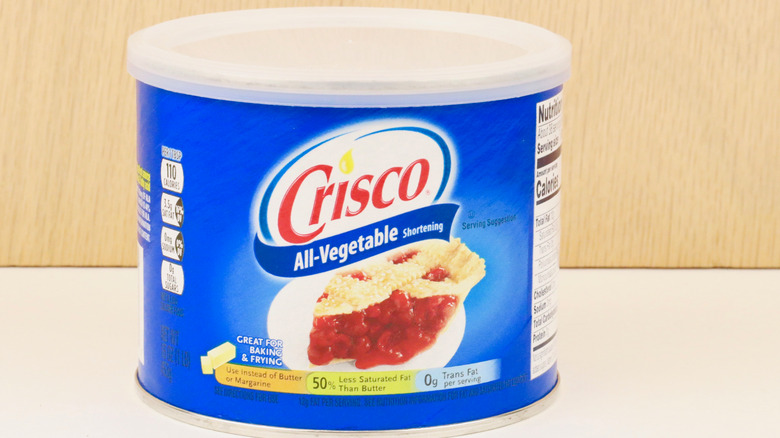How Long Does Crisco Last?
It's probably shoved into the back of your cabinet somewhere. It's not exactly butter (despite being "butter flavored"), but it's not the same thing as lard. We're talking about Crisco, that famous tub of vegetable shortening that has long been a part of the American kitchen, being used in everything from making cookies to greasing up pans.
Unlike butter or lard, Crisco is an invention of the blossoming industrial age of the late 19th century, Smithsonian Magazine tells us, being a product of "liquid plant oil," commonly known as cottonseed oil, following the advent of hydrogenation. The reason for Crisco's popularity was simple: It was flavorless, perfect for frying, and actually appealed to Jewish consumers who couldn't mix meat or dairy. From humble roots as something made of a cotton by-product in the 19th century, Crisco took off, finding a place in every home and restaurant — and in the stomachs of customers, considering how useful its applications were.
Over the years, however, many health activists have cast an eye of suspicion on Crisco, viewing the shortening as an example of America's obsession with trans fats and hydrogenated oils. The Weston A. Price Foundation describes how some doctors and health professionals have begun warning patients against consuming trans fats, cottonseed oil, and Crisco. Still, Crisco remains a classic symbol of industrial foods within the modern kitchen, even if it's not as popular today.
But just how long can that big tub of shortening last in your kitchen?
Crisco can stay good for up to 2 years
If you're cleaning out your kitchen cabinet, you'll probably find a big tub of Crisco somewhere in there. You may not be able to remember when or where you got it, but you still want to know if it's good or not. After all, you wouldn't want a giant tub of expired shortening next to all of your baking goods.
According to Does It Go Bad, Crisco cans and sticks actually have a shelf life of two years. Once opened, you can expect an average can of Crisco to last about a year, while the Crisco sticks can last for about six months. If you're over by a month or so, however, and the product doesn't seem to be spoiled, you can still use the Crisco if you so desire. The USDA, on the other hand, claims that Crisco and other solid shortenings can last up to eight months unopened and, once opened, should be used within the next three months.
Crisco also has a longer shelf life than butter or lard. According to Southern Living, butter has a shelf life in the fridge of about three months, while Can It Go Bad tells us that lard can last four to six months at room temperature or a year in the fridge.
Still, how can you tell when it's time for your Crisco to be tossed?
Look for a darker color in your Crisco
When you first open a container of Crisco, you may notice that it's a milky-white color. If you were to open it again and find that it's changed to a darker color, Lacademie tells us that this is the first sign that something's wrong with your Crisco.
Other warning signs include mold growing around it, a strong, musty smell, and unknown changes in the otherwise smooth texture. Lacademie explains that this could be from either natural expiration or improper storage of shortening, such as next to a heat source. While Eat Delights tells us that no harm can come from eating expired shortening, it will leave your food with an unpleasant taste and smell. Besides, it's not exactly beneficial to eat expired Crisco, even if it doesn't hurt you.
To properly throw away expired or old shortening, Bob Vila explains that you should scoop the congealed shortening into an airtight container and then toss it out with the rest of your kitchen trash. If mold is growing in or around the Crisco package, it's also a good idea to throw away any opened products next to it just to be safe.
While Crisco has a moderately long shelf life compared to butter or lard, it's not a "forever food" and should always be inspected often to ensure it's still usable.


